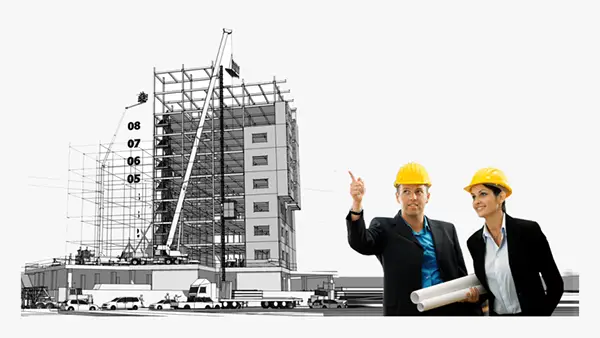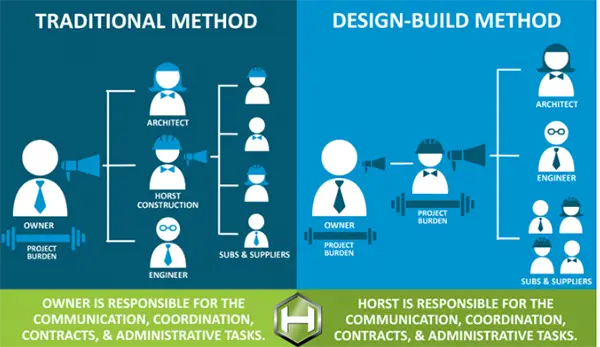
Key Takeaways
- Collaboration is the key to successful commercial design-build projects.
- The shared vision of all the stakeholders involved, results in a more streamlined execution.
- This also helps in the timely scheduling of the projects, as the construction and designing go hand in hand.
- Partnership fosters an environment of innovation and creativity.
- Collaboration in design-build helps team members to stay updated in the constantly evolving environment.
In this rapid world of commercial construction, successful project execution demands a seamless integration of design and construction processes. The design-build approach has emerged as a highly efficient and collaborative method that brings architects, engineers, contractors, and clients together under one umbrella.
Helen Keller once said, Alone we can do so little, together we can do so much. This collaborative model plays a pivotal role in ensuring the success of commercial alternative delivery projects.
In this article, we will explore the significance of collaboration in commercial design-build services and how it contributes to delivering exceptional results.
A Unified Vision from the Outset
One of the key benefits of this partnership in this field is the establishment of a unified vision from the very beginning. Open lines of communication, and this execution of the shared vision, help in preventing costly errors.
With all stakeholders involved in the planning stage, including the client, design-build contractors, and builders, a collective understanding of project goals, requirements, and constraints is developed. This shared vision lays the foundation for a plan that aligns perfectly with the client’s objectives, resulting in a more focused and streamlined execution.
Early Problem Identification and Resolution
It allows potential issues to be identified and addressed at an early stage. Involving construction experts during the design phase, will help to flag possible construction challenges and resolved them before they escalate into costly and time-consuming problems.
This proactive approach leads to a reduction in change orders and project delays, resulting in a smoother and more efficient construction process.
Accelerated Project Timelines

Efficient collaboration between design and construction teams expedites its timelines. Unlike traditional design-bid-build methods, design-build fosters concurrent workflows, where construction can commence while design development is ongoing.
This overlap significantly compresses schedules, ensuring that commercial spaces are completed in a shorter time frame, saving both time and money for clients.
Enhanced Cost Control
Collaboration plays a vital role in controlling costs throughout the project lifecycle. With input from both design and construction professionals, detailed cost estimates can be provided early on, allowing clients to make informed decisions regarding materials, design elements, and project scope.
Do You Know?Identifying this early cost visibility helps prevent budget overruns and enables stakeholders to prioritize pertinent features without compromising quality.
Innovation and Creativity
The synergy created through partnership in commercial design-build often fosters an environment of innovation and creativity. If everyone is moving forward together, then success takes care of itself.
When architects and builders work together, they can explore alternative construction methods, materials, and design concepts that optimize functionality and aesthetics.
This collaborative approach encourages out-of-the-box thinking, resulting in unique and visually stunning commercial spaces.
Fluid Communication and Transparency
Open lines of communication are vital for any successful project. In commercial design-build, collaboration fosters fluid communication among all stakeholders.
Designers, builders, and clients have the opportunity to discuss ideas, share feedback, and address concerns promptly. This transparency ensures that everyone is on the same page throughout the activity, fostering trust and building stronger working relationships.
Focus on Value Engineering
Value engineering, the process of maximizing value while minimizing costs, is its significant aspect.
Collaboration between designers and builders enables the team to find cost-effective solutions without compromising quality.
Value engineering ensures that every aspect of the deal adds value to the final deliverable, by assessing design elements against its objectives and budget constraints.
Responsiveness to Changing Needs
In today’s dynamic business landscape, commercial projects may encounter changes in requirements or scope. Partnership in design-build allows for greater flexibility and responsiveness to changing needs.
When the project team works together, they can quickly adapt to evolving circumstances, offering solutions that meet the client’s needs even as they shift during the construction process.
Interesting fact
By 2025, design-build is estimated to represent 47% of the spending in North America.
Collaboration is the backbone of successful commercial design-build projects. Alliance ensures they are completed on time, within budget, and to the client’s satisfaction, by fostering a unified vision, promoting early problem identification, and accelerating project timelines,
The benefits of enhanced cost control, innovation, fluid communication, and value engineering further solidify the case for embracing it in commercial design-build services. As the construction industry continues to evolve, collaboration remains a key driver of success, transforming ambitious ideas into reality with efficiency and excellence.







